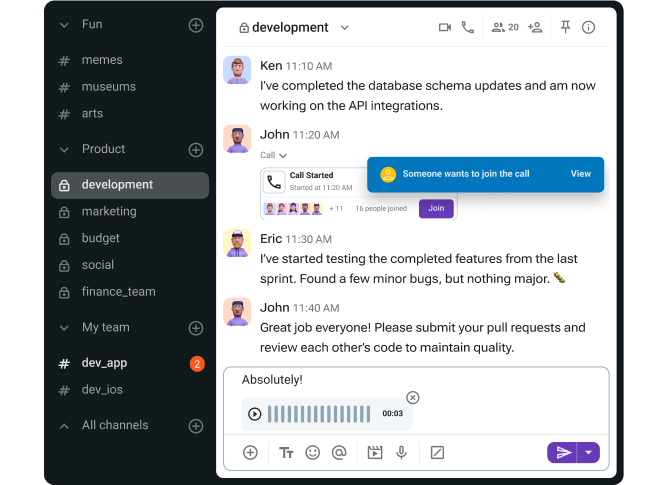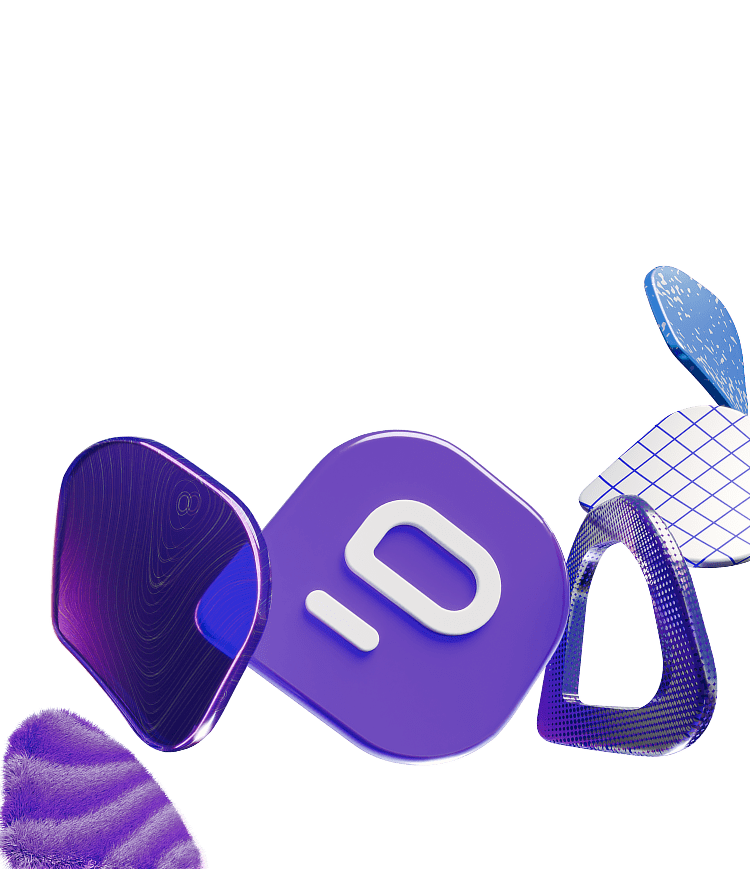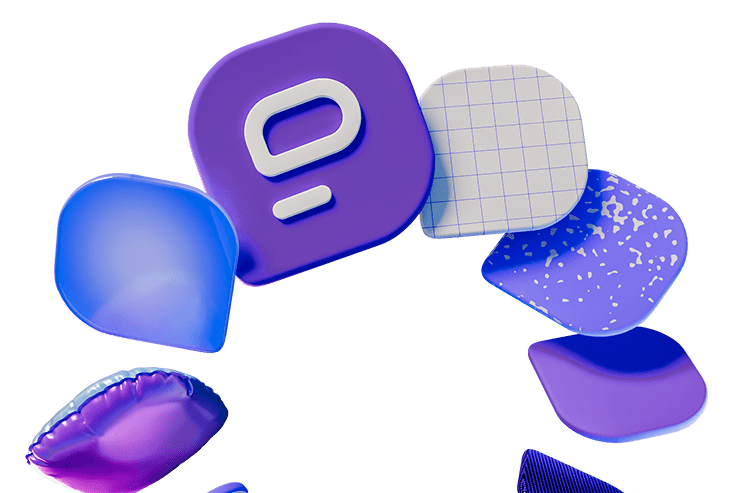Selon les statistiques de l'email marketing pour 2025, les campagnes par email génèrent entre 36 $ et 40 $ pour chaque dollar dépensé. Cela nous montre que les emails sont toujours un pilier de la communication commerciale, aidant les entreprises à atteindre et à attirer des clients cibles au quotidien.
Cependant, les gens se méfient de plus en plus des arguments de vente typiques qu'ils reçoivent chaque jour.
Alors, comment faire pour que vos emails de vente reçoivent des clics et des réponses ?
L'astuce est de les rendre notables.
Et comment y parvenir ?
Bon, c'est un processus plus complexe et en plusieurs étapes que nous allons maintenant explorer ensemble.
Restez à l'écoute car nous allons vous expliquer étape par étape comment vous pouvez vous démarquer avec vos emails de vente. De plus, nous vous proposons nos 10 modèles d'emails pour vous aider à trouver les mots parfaits pour chaque occasion.

Qu'est-ce qu'un email de vente efficace ?
Un email de vente est un outil qui vous aide à vendre vos produits ou services.
Un email de vente parfait est un mélange de connaissances, d'expérience et d'émotions. En d'autres termes, rédiger un bon email de vente est une forme d'art qui contribue à augmenter le chiffre d'affaires de votre entreprise.
Les emails de vente réussis présentent rapidement ce que vous vendez et créent un lien émotionnel avec les clients existants ou potentiels. Rendez-les un peu plus personnels, et vous ferez en sorte que vos clients se sentent encore plus valorisés.
De plus, l'une des principales particularités des meilleurs emails de vente est d'identifier le point sensible de votre client et de présenter votre produit ou service comme la solution idéale.
Maintenant que nous avons défini ce qu'est un email de vente et que nous avons mentionné certaines de ses principales caractéristiques, nous allons vous aider à en rédiger un qui vendra.
🎓 Astuce Pro de Pumble
Si vous rédigez les emails très souvent, ici quelques articles qui peuvent être utiles :
Comment rédiger un email de vente : 7 étapes pour réussir
Il n'existe pas de formule universelle pour rédiger un email de vente parfait.
Mais, il y a des méthodes pour rendre chacun de vos emails de vente unique.
Voici nos meilleurs conseils pour que vos emails de vente soient notables.
Cessez d'attendre des emails ! Découvrez la puissance de la communication avec Pumble
Étape 1 : Définissez votre objectif
Souhaitez-vous envoyer un email commercial à vos clients potentiels ?
Ou bien votre but est-il de renouveler le contrat d'un client existant ?
Quel que soit votre objectif, assurez-vous de le définir clairement, puis d'établir un plan pour l'atteindre.
Si nécessaire, répétez-vous vos objectifs en rédigeant l'email pour être certain de les avoir à l'esprit : « Cet email va me permettre d'obtenir mon premier client ! » ou « Je vais renouveler le contrat de ce client ! »
Notre spécialiste des ventes en entreprise et contributeur, Predrag Rodic, souligne l'importance d'avoir un objectif clairement défini dans vos emails :

« Une chose devrait être commune à tous les emails de vente : l'objectif. Vous ne devriez jamais envoyer un email juste pour le plaisir de l'envoyer. De cette façon, vous ne faites que perdre le temps de vos clients, et en fin de compte, vous perdez aussi le vôtre. »
Définir votre objectif peut vous aider à démarrer et à orienter la conversation dans la bonne direction. Ainsi, vous vous rapprocherez un peu plus de l'envoi de cet email de demande de réunion et de la réalisation de vos objectifs : vendre un produit ou renouveler un contrat.
Étape 2 : Faites vos recherches
Après avoir défini votre objectif, assurez-vous de connaître le plus possible vos prospects ou vos clients.
Predrag, notre contributeur et spécialiste des ventes, vous recommande de faire d'abord une recherche approfondie sur vos prospects :

« Faites vos recherches, ne faites pas d'hypothèses. Cherchez le rôle d'un client sur Google et découvrez ce que fait son entreprise. Vérifiez si cette personne est qualifiée (si elle a besoin de votre produit, de votre solution ou de votre service) et décidez du ton de l'email avant de cliquer sur le bouton “Nouveau message”. »
En d'autres termes, si vous ne connaissez pas suffisamment le client que vous contactez, essayez de recueillir autant d'informations que possible sur lui et son entreprise avant de commencer votre email.
De plus, utilisez vos recherches pour déterminer si l'entreprise :
- a récemment été restructurée,
- a été active sur le marché,
- a une nouvelle direction,
- a obtenu un financement.
Tous ces facteurs peuvent vous aider à déterminer si c'est le bon moment pour envoyer un email de vente.
Vous pouvez appliquer la même logique pour déterminer le moment exact de la journée où vous devez envoyer vos emails. Même si la recherche collective montre que le meilleur moment pour envoyer des emails pour la plupart des campagnes B2B et B2C est entre 9 h et 12 h, ce ne sera pas le cas pour chacun de vos prospects et clients.
En général, votre meilleur moment est d'envoyer vos emails le matin, car la plupart des gens consultent leurs emails à ce moment-là. Cependant, ne considérez pas ces règles comme acquises. Au lieu de cela, tenez compte de toutes les conditions spécifiques qui s'appliquent à vos prospects et clients et adaptez votre approche en conséquence.
Étape 3 : Adoptez la bonne approche
Une fois que vous avez fait vos recherches, vous disposez probablement d'une tonne d'informations sur vos clients.
Toutefois, cela ne veut pas dire que vous devez écrire la biographie complète du client dans votre email de vente.
Au contraire, si vous contactez un client pour la première fois, gardez la majeure partie de ces informations pour vous jusqu'à ce que vous en ayez besoin.
Suivez le conseil de Predrag que vos emails doivent être courts et concis :

« Si vous souhaitez faire une offre directe par email, vous voudrez probablement être aussi concis que possible et tout résumer en 3 ou 4 phrases percutantes qui suscitent l'intérêt d'un prospect. »
En revanche, si vous contactez un client déjà fidélisé, n'hésitez pas à entrer dans les détails.
Predrag explique que vous ne devriez pas vous retenir dans ces cas-là :

« Si un client fidèle a besoin d'informations cruciales pour son renouvellement, son manager de compte (MC) ne devrait probablement pas hésiter à ajouter quelques mots supplémentaires pour décrire une solution. »
Étape 4 : Adaptez le ton de votre email
Pourquoi certains spécialistes des ventes ont-ils plus de succès que d'autres ?
La réponse pourrait résider dans le fait qu'ils savent ajouter la touche personnelle parfaite aux mots et expressions de communication professionnelle dans leurs emails.
En d'autres termes, les meilleurs spécialistes des ventes savent comment ajuster le ton de leurs emails.
Pour vous aider à atteindre le ton parfait dans vos emails, Predrag vous rappelle de rester naturel :

« Essayez d'être vous-même. Ne soyez pas trop formel, personne ne parle comme ça en personne. Si vous voulez avoir l'air professionnel, au lieu d'utiliser de grands mots, montrez à votre client ce que vous pouvez faire pour lui. »
Utiliser trop de mots à la mode et d'expressions d'entreprise ennuyeuses peut rendre vos emails de vente ternes et contre-productifs.
D'un autre côté, l'humour et un peu de jargon sont bienvenus, mais n'en faites pas trop, comme le suggère Predrag.

« N'utilisez pas trop de jargon. Évitez surtout l'abus du jargon commercial et des grands mots d'entreprise à la mode. Même si l'humour est toujours le bienvenu, n'en faites pas des tonnes. C'est bien de faire rire un client une ou deux fois en lisant votre email, mais n'oubliez jamais l'objectif de votre email. Et, corrigez toujours vos emails ! »
🎓 Astuce Pro de Pumble
Puisqu'un humour est apprécié, les signatures d'email amusantes pourraient être votre arme secrète pour ajuster le ton de votre email.
Consultez l'article de blog suivant pour des exemples :
Étape 5 : Ajoutez un objet d'email percutant
Vous ne voulez pas que votre email, si bien conçu, finisse dans les spams simplement parce que vous n'avez pas prêté assez d'attention à l'objet.
En effet, environ 70% des emails sont signalés comme spam uniquement à cause de leur objet.
Donc, assurez-vous de suivre notre conseil — trouvez toujours un objet d'email percutant, surtout lorsque vous contactez un client pour la première fois.
Bien qu'il n'y ait pas de tactique infaillible pour rédiger un objet accrocheur, en inclure certains éléments pourrait le rendre plus efficace :
- Le nom du client,
- L'objectif de l'email, ou
- Une courte question.
Étape 6 : Incluez un Appel à l'action et des informations sur les prochaines étapes
Si vous laissez votre prospect sans un appel à l'action (en anglais : Call-to-Action, CTA) ou des informations supplémentaires sur les prochaines étapes, il y a de fortes chances que vous n'obteniez pas de réponse.
Ils ne savent peut-être tout simplement pas quoi faire ensuite et décident d'éviter toute autre conversation.
De l'autre côté, un appel à l'action bien formulé encourage les prospects à rester engagés.
Les CTA les motivent à :
- Vous répondre,
- Planifier un rendez-vous, ou
- Effectuer toute autre action menant à un accord.
De plus, les questions ouvertes augmentent vos chances d'obtenir la réponse que vous souhaitez.
Évitez de demander « Est-ce que cela vous convient de fixer un rendez-vous lundi ? » , car un prospect pourrait simplement répondre « Non, j'ai beaucoup de choses à faire à ce moment-là. Désolé. »
Comme vous pouvez l'imaginer, il est impossible de maintenir la conversation après une réponse aussi sèche.
Préférez plutôt une question comme : « Que pensez-vous de fixer un rendez-vous en début de semaine prochaine ? Lundi vous conviendrait-il ? »
Les questions ouvertes comme celle-ci sont toujours utiles pour obtenir plus d'informations.
Étape 7 : Faites une suite de la conversation
Vous avez suivi nos conseils, envoyé l'email parfait, mais vous n'avez eu aucune réponse.
Vous vous demandez donc : et maintenant ?
C'est le moment d'envoyer un email de suivi personnalisé et soigneusement rédigé pour rappeler poliment au prospect de votre précédent message.
Cela ne signifie pas que le premier email de vente était mal rédigé ou inapproprié. Vos prospects ne l'ont peut-être pas vu, l'ont ignoré par erreur, ou ont oublié de répondre.
Ne vous limitez pas non plus à envoyer des emails de suivi uniquement si vous n'avez pas reçu de réponse à votre premier email de vente.
Il est tout à fait normal d'envoyer un email de suivi après une réunion ou un événement réussi.
Ces emails servent à rappeler les détails que vous avez abordés et à vérifier si vos prospects ont besoin d'aide.
Predrag Rodic, notre collaborateur, a partagé ses réflexions sur la vente que vous devriez toujours garder à l'esprit lorsque vous cherchez à engager vos prospects :

« À moins que vous ne vendiez des bouteilles d'oxygène à des stations spatiales en orbite, soyez conscient que votre produit ou service pourrait ne pas être une priorité absolue pour vos clients, et qu'ils pourraient être assez inertes lorsqu'il s'agit de faire avancer les choses. »
Adoptez donc une approche proactive et faites tout votre possible pour faire avancer les choses.
Oubliez les échanges incessants d'emails : communiquez plus efficacement dans Pumble
Modèles d'emails commerciaux
Pour vous aider à mieux comprendre le concept d'emails de vente uniques, nous avons créé une liste des meilleurs modèles que vous pouvez utiliser pour contacter vos clients existants et vos clients potentiels.
Sans plus attendre, voici les 10 meilleurs modèles d'emails de vente qui garantissent le succès.
#1 Modèle d'email commercial pour attirer l'attention
Voici à quoi peut ressembler votre email de vente court pour attirer l'attention.
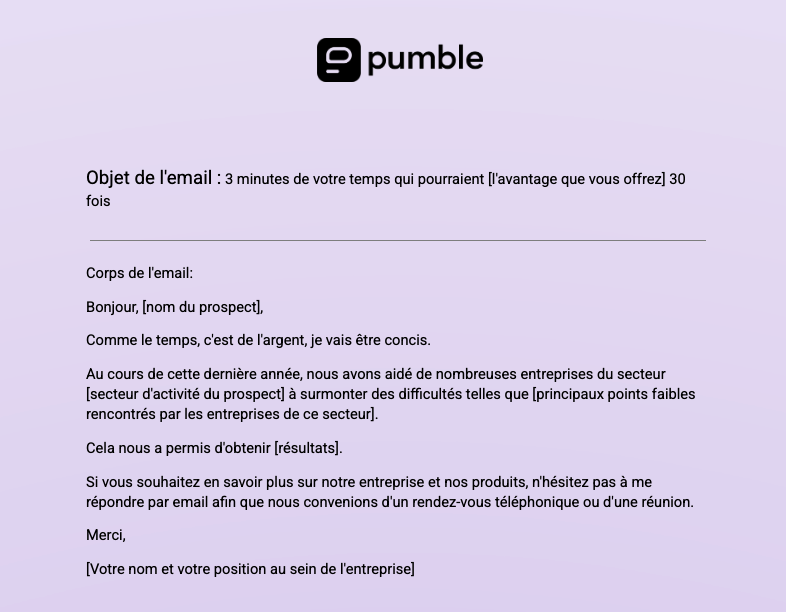
Téléchargez le modèle d'email pour attirer l'attention
Comment rédiger un email de vente pour attirer l'attention ?
Pour attirer l'attention par email, suivez les conseils mentionnés ci-dessus :
- Soyez concis,
- Mentionnez vos clients existants et la manière exacte dont vous les avez aidés,
- Présentez les résultats qu'ils ont obtenus après avoir acheté votre produit ou service.
N'oubliez pas d'insérer un appel à l'action (CTA) à la fin de votre email de vente.
Comment rédiger un email de vente pour attirer l'attention ?
Le pitch de vente par email est l'un des meilleurs emails de vente, car il respecte les règles de base de la rédaction d'emails de vente.
Il est concis, informatif et laisse un appel à l'action clair à un prospect.
C'est pourquoi il est idéal pour tâter le terrain en vue de décrocher de nouveaux clients.
#2 Modèle d'email commercial basé sur une demande
Vous avez besoin d'inspiration pour rédiger votre premier email basé sur une demande ? Voici notre modèle pour vous aider à démarrer.
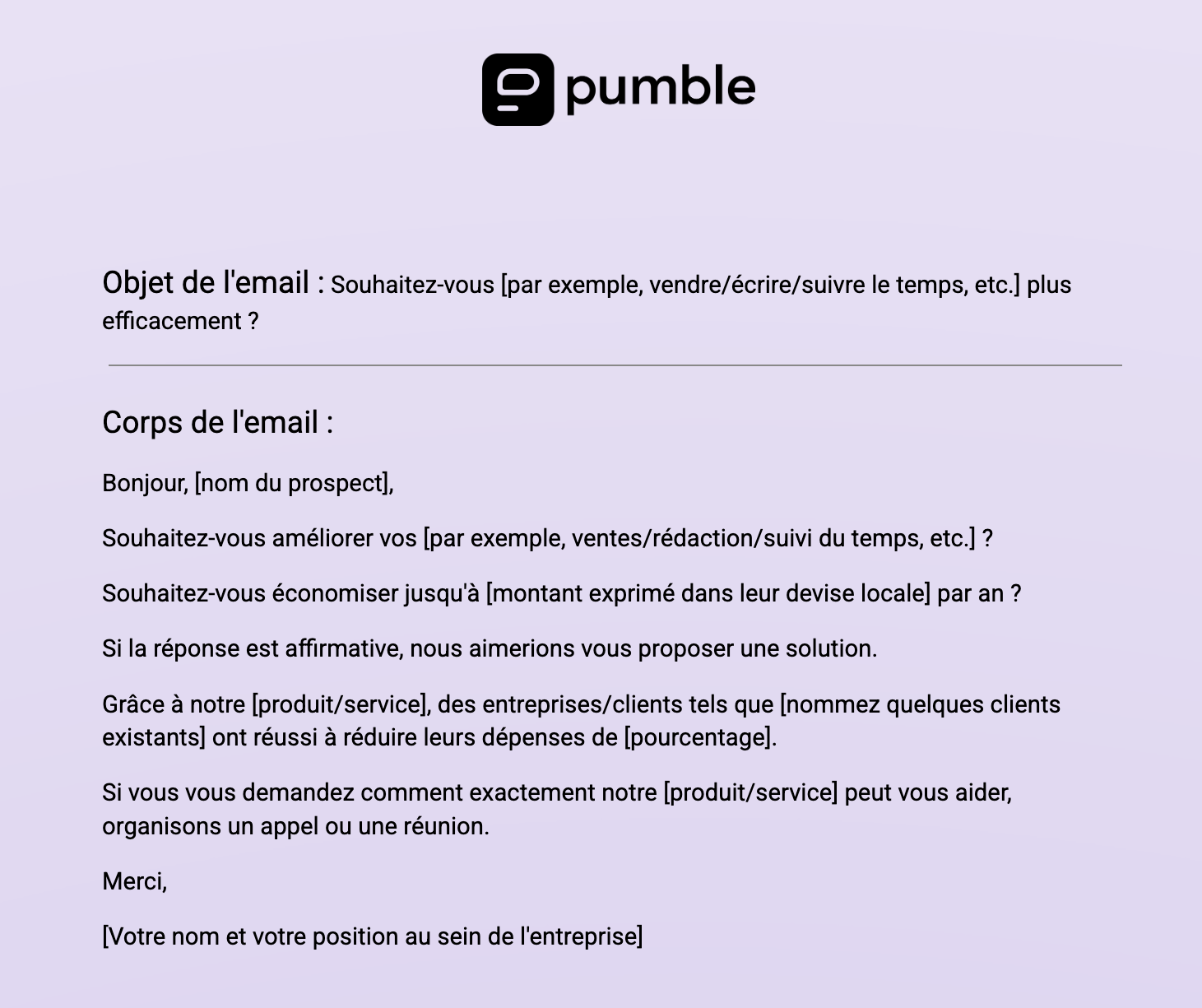
Téléchargez le modèle d'email commercial basé sur les demandes
Comment rédiger un email de vente basé sur les demandes ?
Lorsque vous rédigez des emails de vente basés sur les demandes de renseignements, l'essentiel est de poser les bonnes questions.
Comme vous l'avez vu ci-dessus, nous avons utilisé des questions un peu plus génériques sur les améliorations et les économies.
Si vous en savez plus sur le prospect et ses revenus ou ses activités, n'hésitez pas à ajouter des questions basées sur des données.
Cependant, après avoir posé les questions, veillez à fournir également les réponses concernant votre produit ou service et la manière dont ils peuvent aider le prospect. Si nécessaire, mentionnez comment vous avez aidé d'autres clients et citez les données exactes pour étayer vos affirmations.
Par exemple : « En utilisant XYZ, ZYX a réduit ses dépenses de 30 % par rapport à l'année dernière. »
Si vous n'avez pas encore de clients ni de données, utilisez les estimations que vous pouvez garantir.
Bien sûr, votre email commercial basé sur des questions doit se terminer par un CTA fort.
Comment rédiger un email de vente basé sur les demandes ?
Les emails commerciaux basés sur des questions servent à tâter le terrain. Ils peuvent être « l'appât » idéal pour susciter l'intérêt des clients potentiels pour votre produit.
Les questions posées au début de votre email peuvent le faire ressortir parmi les centaines d'autres que vos prospects reçoivent chaque jour.
De plus, si vous fournissez des statistiques sur la façon dont votre produit/service peut faire la différence, vous avez de bonnes chances d'obtenir une réponse.
Il est donc essentiel de :
- Mener des recherches minutieuses,
- Poser les bonnes questions et
- Donner des réponses qui susciteront la curiosité du prospect à l'égard de votre offre.
#3 Modèle d'email commercial de résolution de problèmes
Les emails de résolution de problèmes peuvent considérablement améliorer vos ventes.
Regardez l'exemple.
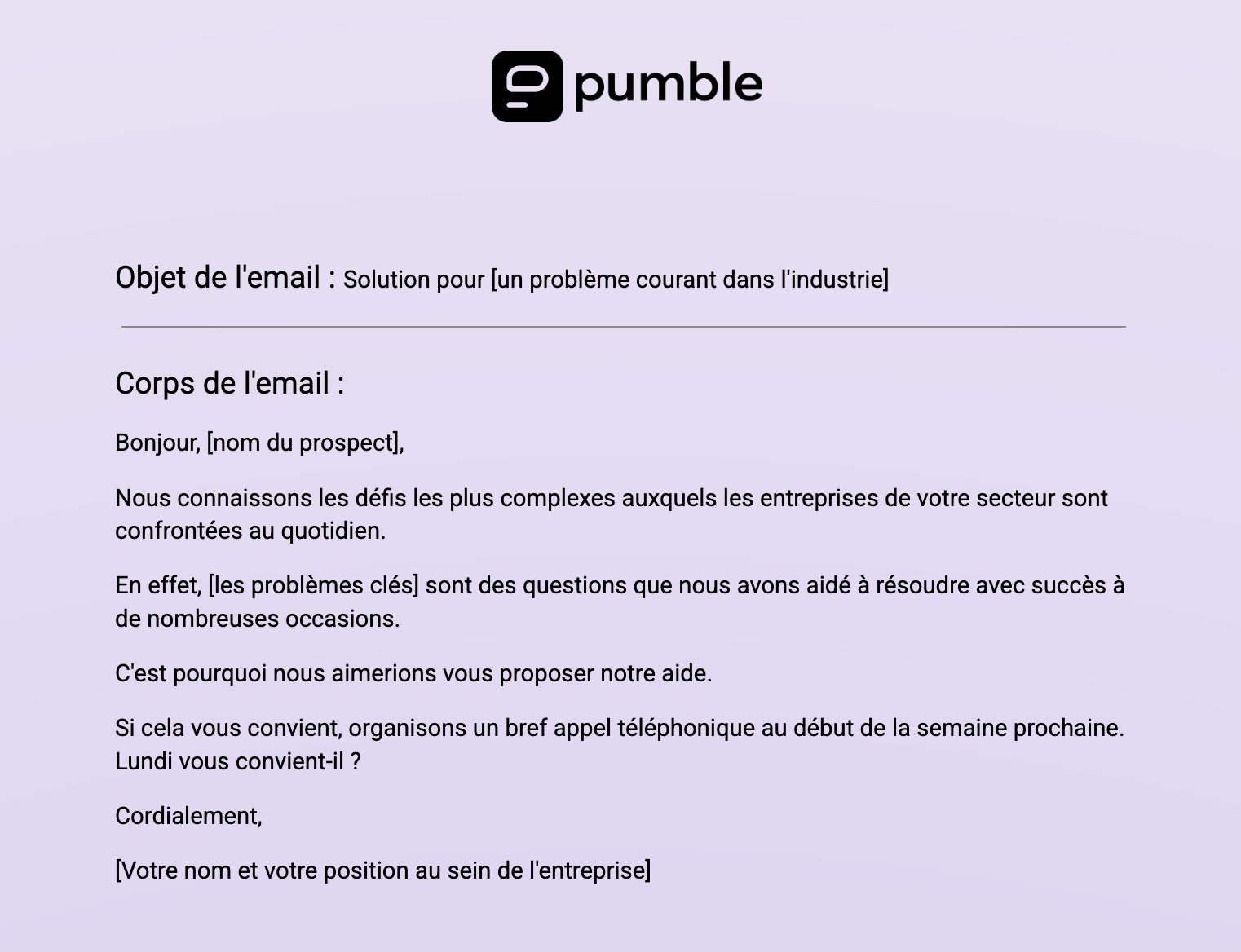
Téléchargez le modèle d'email commercial de résolution de problèmes
Comment rédiger un email de vente qui résout un problème ?
Pour rédiger des emails de vente efficaces, vous devez faire des recherches approfondies pour bien comprendre les défis de vos prospects.
Une fois que vous avez cerné leurs principaux problèmes, mentionnez-les dès le début de votre email.
De cette façon, le prospect verra immédiatement que vous avez fait vos devoirs et que vous savez de quoi vous parlez.
Après avoir exposé un problème, proposez les solutions que votre produit ou service peut apporter. Si possible, illustrez ces solutions avec des exemples concrets, en montrant comment votre produit a aidé vos clients existants.
Grâce à un appel à l'action (CTA) clair ou à d'autres informations que vous incluez, vos prospects sauront quoi faire s'ils sont intéressés par votre offre.
Pourquoi utiliser un email de vente de résolution de problèmes ?
Si vous apprenez qu'une entreprise fait face à un problème majeur et que vous pensez avoir la solution idéale, ce type d'email pourrait être votre atout majeur.
Imaginez, par exemple, que vous travaillez pour le service commercial d'une entreprise informatique qui a développé un logiciel de communication interne.
Vous entendez ou lisez qu'une entreprise en pleine croissance rencontre des problèmes de mauvaise communication interne, car elle a embauché de nombreuses personnes en peu de temps.
Simplifier la communication interne avec Pumble
Que feriez-vous ?
C'est là que les emails de vente sur la résolution de problèmes entrent en jeu. Vous identifiez leurs difficultés et leur proposez une solution.
Espérons que votre première prise de contact marquera la fin de leurs problèmes et le début d'une collaboration fructueuse.
#4 Modèle d'email commercial pour féliciter
Féliciter quelqu'un pour son succès est un bon moyen d'ouvrir la voie à une future collaboration.
Découvrez à quoi peut ressembler un modèle d'email commercial de félicitations.
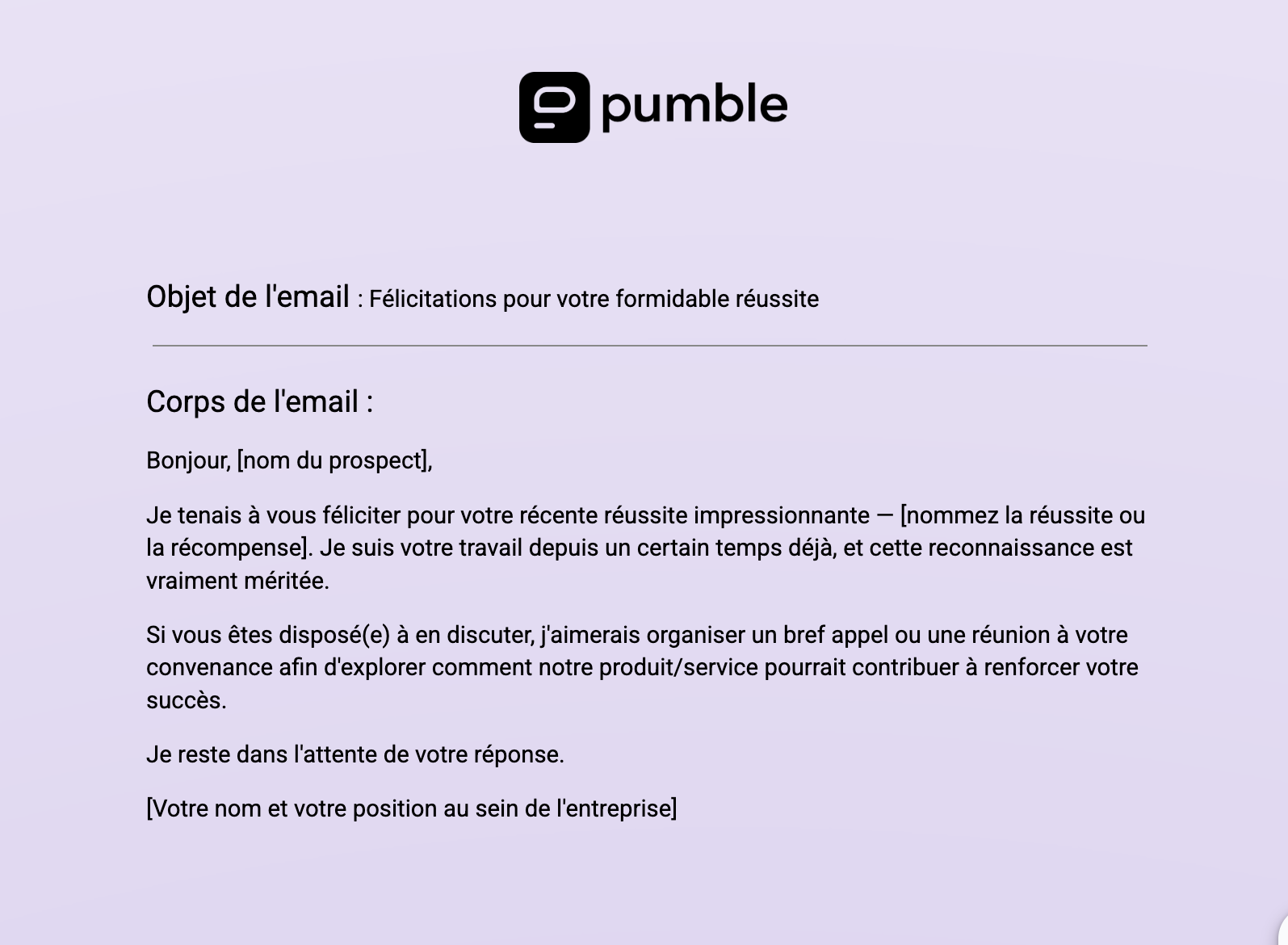
Téléchargez le modèle d'email commercial de félicitations
Comment rédiger un email de vente pour féliciter ?
Si un prospect a connu un succès professionnel, c'est le moment de lui envoyer un email de félicitations.
Commencez votre email en félicitant le prospect pour sa réussite. Vous pouvez expliquer pourquoi il mérite son succès, mais veillez à ne pas en faire trop.
Si vous exagérez, vous risquez de passer pour un opportuniste. Soyez bref et concis.
Ce n'est qu'après avoir terminé la première partie que vous pouvez passer à la suivante — ouvrir la porte à une réunion/un appel et à une éventuelle collaboration future.
Cependant, veillez à ne pas trop promouvoir votre marque, car cela pourrait sérieusement ruiner vos chances.
Une phrase percutante suffit.
Pourquoi rédiger un email de vente pour féliciter ?
Un email de félicitations n'est pas un exemple classique d'email de prospection.
Au contraire, il attire l'attention du client sans intention apparente de conclure la vente le plus rapidement possible.
De plus, si vous félicitez quelqu'un pour son succès, il n'est pas poli de pousser agressivement à une collaboration, car cela ne ferait que provoquer l'effet inverse.
Laissez le prospect profiter de son succès, mais profitez de ce moment pour tâter le terrain en vue d'une future collaboration. Si le client potentiel est disposé à travailler avec vous, il le montrera tôt ou tard.
Après tout, vous pouvez toujours envoyer des emails de suivi pour poursuivre le travail commencé par les emails de félicitations.
Vous en avez assez des emails? Testez Pumble
#5 Modèle d'email commercial d'introduction
Comme son nom l'indique, un email de vente d'introduction a pour but de présenter à un prospect le service ou le produit que vous proposez.
Voici notre version d'un modèle d'email de vente d'introduction pour les nouveaux clients.
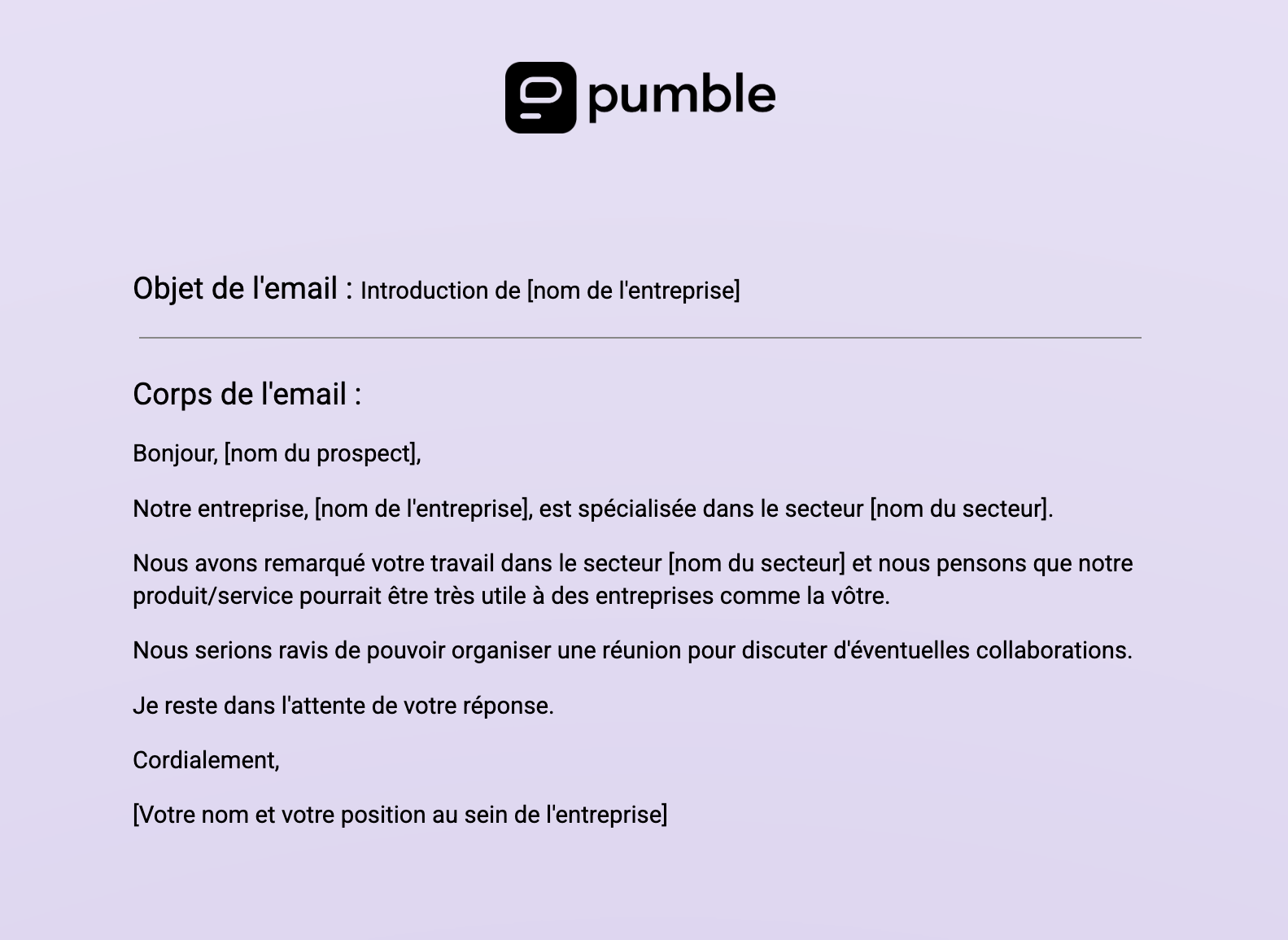
Téléchargez le modèle d'email commercial d'introduction
Comment rédiger un email de vente d'introduction ?
Un email de vente d'introduction sert à présenter votre entreprise.
Vous pouvez donc en profiter pour donner quelques informations de base sur ce que vous faites.
C'est aussi une bonne pratique d'établir un lien avec un prospect en mentionnant que vous avez vu ce qu'il fait et qu'il y a une opportunité de collaboration.
Enfin, il est important d'inclure un appel à l'action (CTA). Vous pouvez en créer un vous-même ou utiliser le même modèle que nous, comme « En espérant avoir bientôt de vos nouvelles ».
De plus, un email de vente d'introduction doit idéalement inclure des données qui prouvent que votre service ou produit est ce dont le prospect a besoin.
Pourquoi rédiger un email de vente d'introduction ?
Un email de vente d'introduction de base est idéal lorsque vous n'êtes pas sûr de l'approche à adopter avec des clients potentiels.
Il informe le client de votre offre et lui laisse l'initiative de la suite.
Cependant, veillez à ne pas ennuyer vos clients avec une formulation trop générique. Efforcez-vous toujours d'atteindre une personnalisation maximale pour maintenir leur intérêt et leur engagement.
Intégrez facilement vos nouveaux clients avec Pumble
#6 Modèle d'email commercial base sur un contact mutuel
Un ami d'un ami est le nouveau PDG d'une grande entreprise. Une excellente nouvelle pour lui, vous diriez.
Une excellente nouvelle pour vous aussi, dirions-nous.
Avoir des amis bien placés peut vous ouvrir pas mal de portes.
Pour profiter au maximum de cette opportunité, utilisez ce contact en commun comme d'un tremplin vers le succès.
Voici des exemples d'emails commerciaux basés sur un contact en commun.
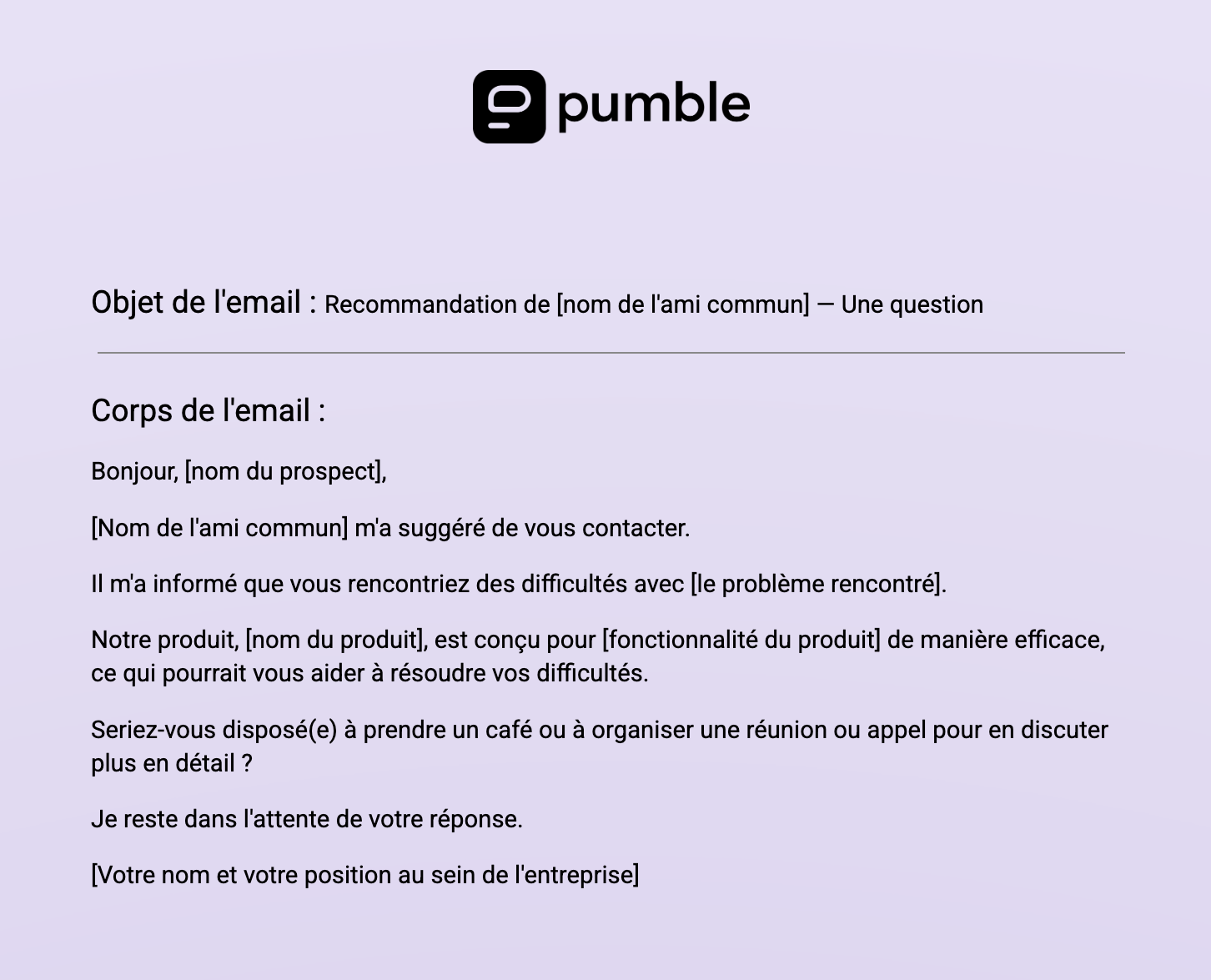
Téléchargez le modèle d'email de vente basé sur un contact mutuel
Comment rédiger un email de vente basé sur un contact mutuel ?
Avant d'écrire un email de vente en utilisant un contact mutuel, demandez à votre ami s'il est d'accord que vous utilisiez votre lien pour entrer en contact avec un prospect.
Si c'est le cas, mentionnez-le immédiatement dans la ligne d'objet.
De cette façon, vous attirez l'attention de votre prospect et augmentez vos chances de réussite. Cependant, comme vous pouvez le voir ci-dessus, il est essentiel d'énoncer un problème ou une difficulté et d'expliquer comment votre produit ou service peut aider à le résoudre.
Un simple appel à l'action (CTA) à la fin est un bon moyen de conclure l'email de vente.
Pourquoi rédiger un email de vente basé sur un contact mutuel ?
En tant que spécialiste des ventes, vous devriez utiliser tout ce qui est à votre disposition pour conclure une affaire. Cela inclut aussi les contacts mutuels.
Ainsi, si vous pensez que la mention de votre contact mutuel pourrait vous ouvrir les portes d'une affaire potentielle, il n'y a rien de mal à cela, tant que cette personne est d'accord.
Mentionner un ami que vous avez en commun pourrait attirer l'attention du client. De plus, il pourrait se sentir obligé de répondre par respect pour votre ami commun.
#7 Modèle d'email commercial pour relancer un client existant
Contacter un client existant ne devrait pas être compliqué si vous suivez les instructions ci-dessous.
Mais avant de passer aux instructions, découvrons un exemple d'email de vente conçu pour relancer un client existant.
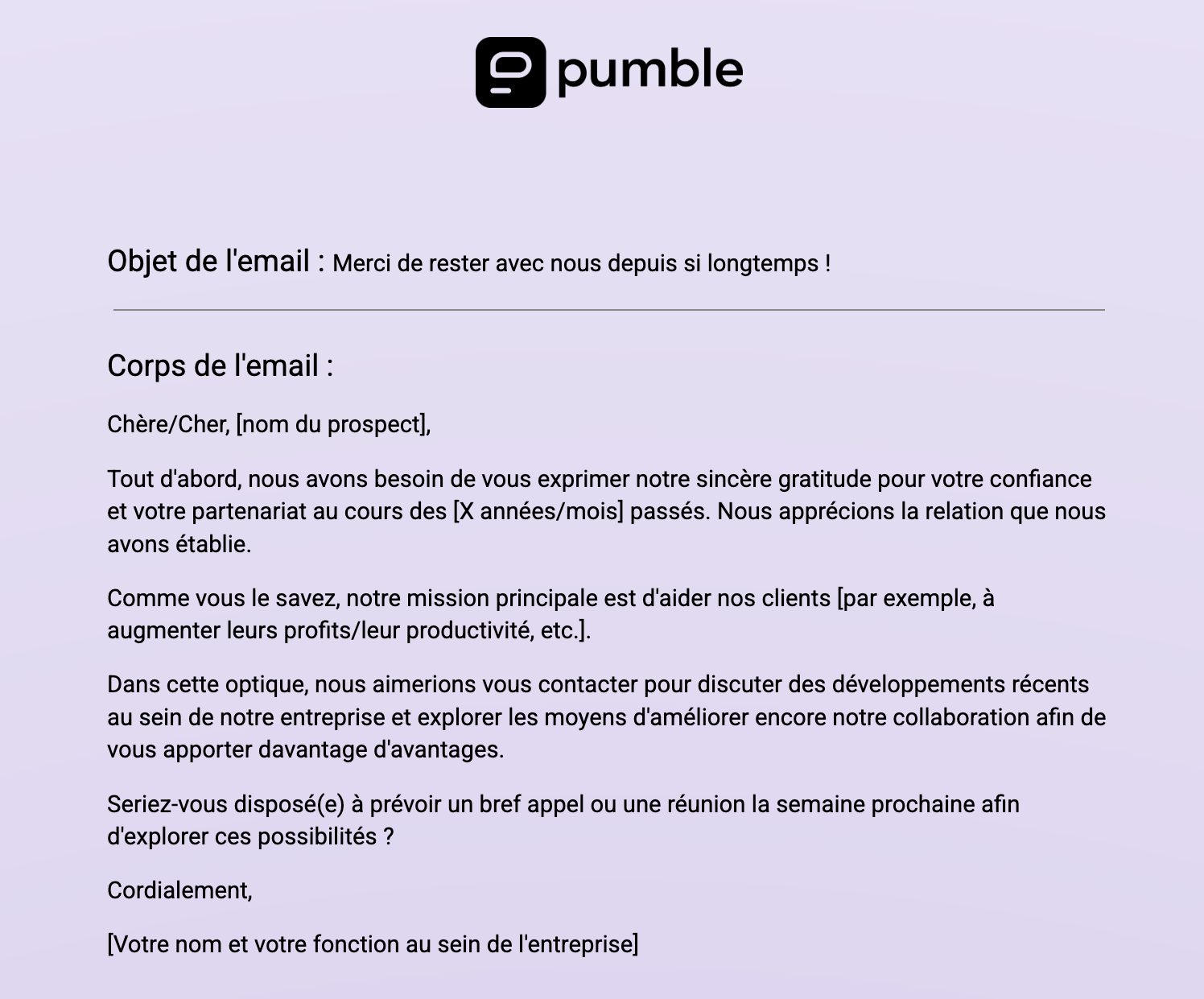
Téléchargez le modèle d'email commercial pour relancer un client existant
Comment rédiger un email de vente pour relancer un client existant ?
- Tout d'abord, exprimez votre gratitude à votre client pour sa fidélité.
- Ensuite, rappelez-lui les avantages de votre produit ou service et comment il contribue à sa réussite.
- Après avoir préparé le terrain, proposez un rendez-vous pour en discuter.
Comme vous avez déjà établi une relation de confiance, il ne devrait pas y avoir de problème si vous proposez directement une heure précise pour un appel ou une réunion.
Cependant, comme nous l'avons vu plus haut, nous nous en sommes tenus à la tactique éprouvée consistant à laisser les clients choisir le moment qui leur convient le mieux.
Pourquoi rédiger un email de vente pour relancer un client existant ?
Relancer des clients existants est essentiel.
En adoptant une approche proactive et en relançant les clients déjà acquis, vous pouvez récolter les fruits suivants :
- Réduire les risques de résiliation de contrat,
- Rappeler à vos clients les bénéfices de votre collaboration pour les deux parties,
- Préparer le terrain pour le renouvellement du contrat.
Restez en contact avec vos clients avec Pumble
#8 Modèle d'email commercial amical
L'envoi d'emails à vos clients existants ne doit pas toujours mener à une vente immédiate. Certains emails, comme l'email de vente amical, peuvent servir à préparer le terrain pour de futures discussions fructueuses.
Voici à quoi il ressemble.
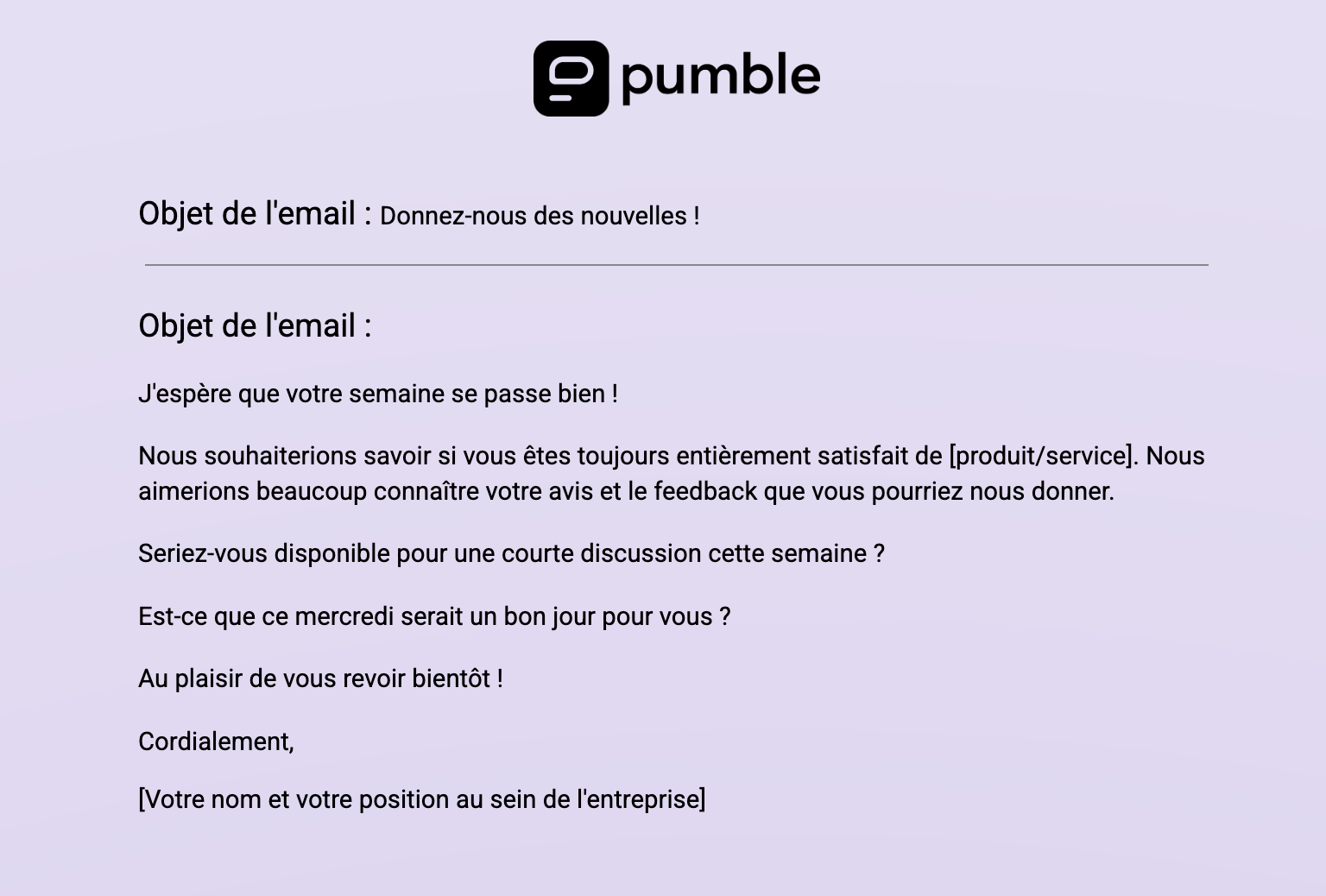
Téléchargez le modèle d'email commercial amical
Comment rédiger un email de vente convivial ?
Pour composer ce type d'email, vous devez être prêt à vous concentrer sur ce que vos clients ont à dire.
Vous devez prendre au sérieux les commentaires de vos clients et en discuter, que ce soit par le biais d'un email de suivi ou lors d'un appel ou d'une réunion officielle qui, espérons-le, aura lieu.
Pour organiser une réunion, vous devriez laisser un CTA clair. Cependant, un CTA n'a pas besoin d'être trop formel, puisque le client est déjà familiarisé avec votre façon de travailler et de communiquer.
Organiser des réunions productives sur Pumble
Pourquoi rédiger un email de vente convivial ?
Comme l'a mentionné notre contributeur Predrag ci-dessus, il est important de rester en contact avec les clients déjà intégrés.
L'une des façons d'entretenir ce lien est de prendre de leurs nouvelles de temps en temps.
De plus, vous pouvez leur demander s'ils ont des suggestions ou des impressions concernant vos produits.
Cela montre à vos clients à quel point vous appréciez leur opinion et leur satisfaction.
#9 Modèle d'email commercial pour une période d'essai gratuit
Excellente nouvelle !
Votre entreprise vous donne l'opportunité d'offrir des essais gratuits à vos clients actuels afin de les fidéliser.
C'est une situation idéale pour les équipes de vente, car cela permet de renforcer la confiance des clients en leur offrant quelque chose de valeur gratuitement.
Si vous cherchez un modèle d'email de vente pour un essai gratuit, en voici un exemple ci-dessous.
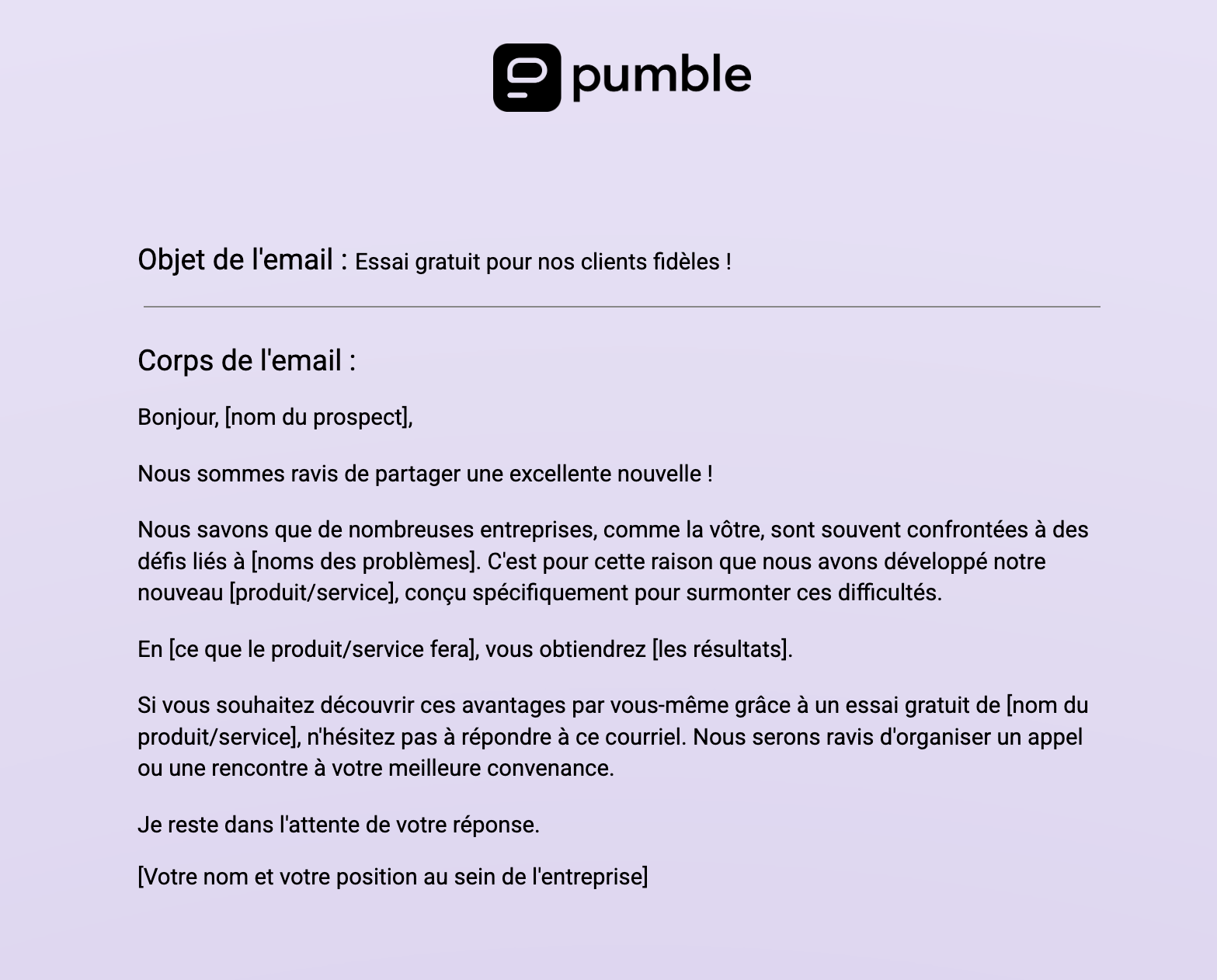
Téléchargez le modèle d'email de vente pour un essai gratuit
Comment rédiger un email de vente pour offrir un essai gratuit ?
Tout le monde aime les cadeaux. Assurez-vous donc de bien préciser que votre offre est gratuite, y compris dans l'objet de votre email.
Bien que nous ne recommandions pas cette approche avec des prospects, il n'y a aucune raison de ne pas offrir des choses gratuites à vos clients existants.
Dans le corps de votre email, expliquez pourquoi vous offrez votre produit ou service gratuitement et comment il peut leur être bénéfique.
Cependant, tout le monde ne sera pas intéressé par votre offre.
Veillez donc à inclure un appel à l'action (CTA) pour organiser une réunion où vous expliquerez pourquoi vous pensez qu'ils devraient au moins envisager de faire un essai gratuit.
Pourquoi rédiger un email de vente pour offrir un essai gratuit ?
L'envoi d'emails de vente basés sur des essais gratuits est une situation où tout le monde gagne.
Les clients peuvent avoir un aperçu du dernier produit, tandis que vous pourriez éventuellement conclure une nouvelle vente.
De plus, tout retour client est bénéfique.
Remplacer les emails et collaborer plus efficacement avec Pumble
#10 Modèle d'email de relance après une silence (sans réponse)
Si votre client potentiel n'a pas répondu à votre email dans les 2 ou 3 jours ouvrables, il est temps d'envoyer un email commercial pour maintenir le contact.
Voici à quoi devrait ressembler un email commercial après un silence.
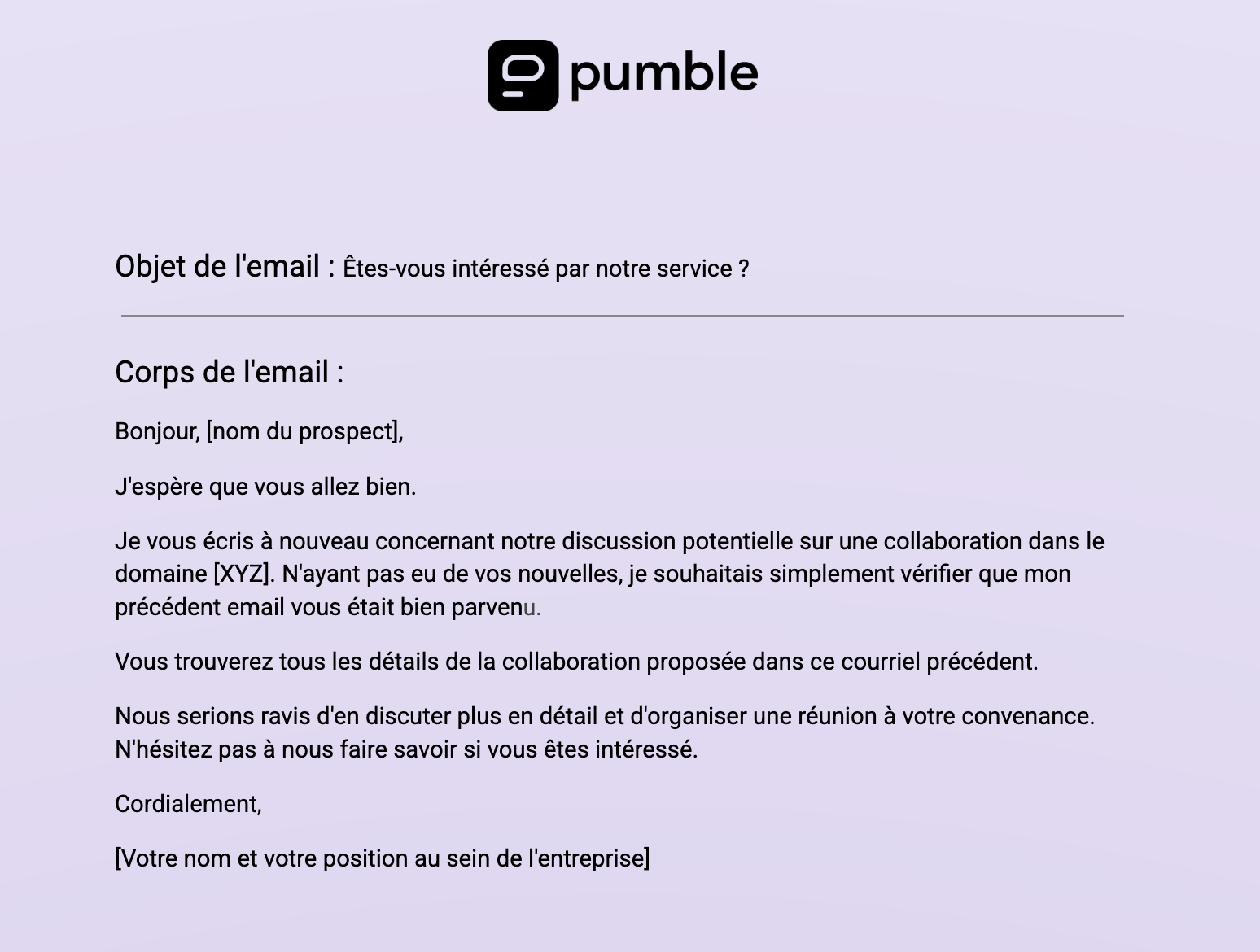
Téléchargez un modèle d'email de vente après absence de réponse
Comment rédiger un email commercial après un silence ?
Votre email de vente du suivi doit être personnalisé.
Dans le cas contraire, il n'apporte aucune valeur tangible à vos clients.
Commencez par une ligne d'objet qui rappelle poliment à votre client qu'il a oublié de vous répondre.
Dans le corps de l'email, expliquez que vous l'avez contacté mais que vous n'avez pas reçu de réponse.
De plus, il est préférable de ne pas répéter les détails du précédent email. Au lieu de cela, invitez vos clients à le relire par eux-mêmes. Cela fait plus professionnel, car vous ne voulez pas vous répéter à chaque email.
Ensuite, expliquez la nature de votre dernier email en une ou deux phrases et insérez un nouvel appel à l'action (CTA).
Pourquoi rédiger un email commercial après un silence ?
En tant que spécialiste de la vente, vous avez besoin d'une réponse à votre offre. Votre meilleure chance d'en obtenir une est d'envoyer un email commercial.
Bien sûr, la réponse peut être négative, mais au moins, vous saurez où vous en êtes.
Soyez proactif et découvrez s'il y a une possibilité de collaboration ou non.
Augmentez vos ventes avec Pumble
L'envoi des emails de ventes reste une pratique courante dans le domaine de la vente.
Bien que l'email reste un canal de communication acceptable et traditionnel, il ne s'agit que d'une option parmi tant d'autres dans le spectre commercial actuel.
L'utilisation des applications de communication innovantes comme Pumble peut offrir de bonnes fonctionnalités et une efficacité bien supérieures au courriel traditionnel.
Pumble est un logiciel de collaboration d'équipe qui constitue une solution polyvalente pour les professionnels de la vente et une excellente alternative au mail.
Il vous permet de remplacer les longues chaînes d'emails et de simplifier votre communication avec vos clients grâce à :
Avez-vous déjà eu peur d'oublier de mettre une personne clé en copie conforme (CC) dans une chaîne d'emails ?
Pumble élimine complètement ce problème.
Contrairement au mail, Pumble offre une plateforme centralisée pour une communication fluide, le brainstorming et le partage efficace de ressources.
Partagez des fichiers et des idées avec toutes les parties concernées en une seule fois, sans les CC agaçants et la peur constante d'oublier quelqu'un ou quelque chose.
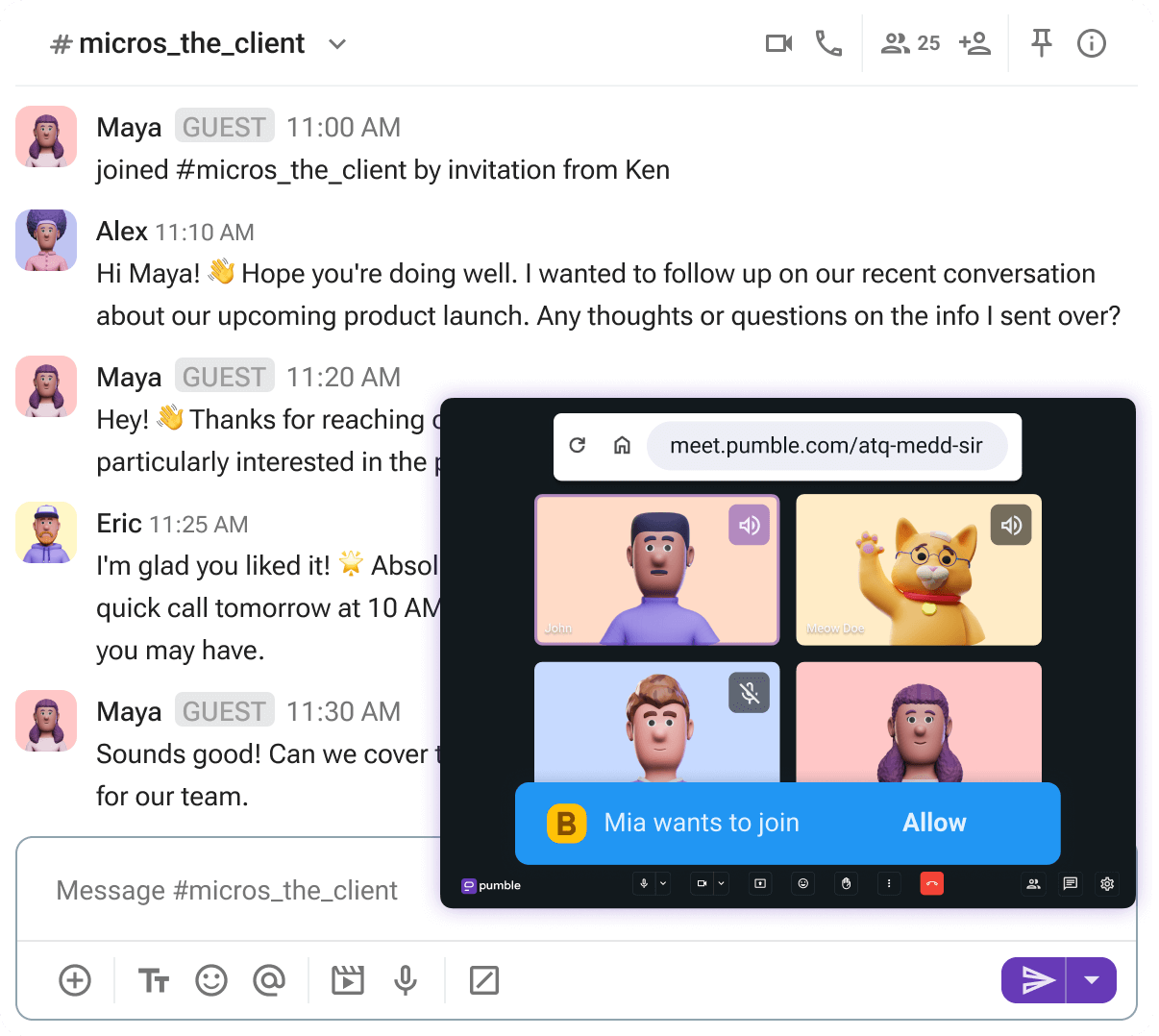
Pumble de CAKE.com vous permet d'inviter des partenaires ou des clients externes à votre entreprise à rejoindre votre espace de travail et à collaborer dans des canaux. Vous décidez des rôles et des permissions qui sont attribués aux invités, y compris les limites de temps et de canaux.
Centralisez la communication avec vos clients dans Pumble
L'historique de communication de l'ensemble de votre espace de travail est consultable, et cela signifie que vous n'avez pas besoin d'envoyer une tonne de mails aux nouveaux membres, car toutes les informations clés sont facilement accessibles.
De plus, collaborer sur Pumble protège votre communication contre le spam, le phishing et les attaques de logiciels malveillants, auxquels les emails sont vulnérables.
Grâce à l'interface intuitive et aux fonctionnalités avancées de Pumble, les équipes de vente peuvent :
- Simplifier leur communication,
- Favoriser une meilleure collaboration, et
- Accélérer leur réussite commerciale.
Êtes-vous prêt à en finir avec les boîtes de réception saturées et à faire l'expérience d'une collaboration client organisée et efficace ?
Comment nous examinons cet article : Nos rédacteurs et éditeurs vérifient les articles et les mettent à jour lorsque de nouvelles informations sont disponibles, afin qu'ils soient toujours d'actualité.